Synderella: How Noah Syndergaard went from awkward kid to Mets ace

The kid in the yearbook photo is you. He is me. He is everyone who was ever mired in adolescent awkwardness. He is 5' 11"—tall for his 14 years—and he weighs 180 pounds, much of it baby fat beneath his XXL T-shirt. He has glasses, a bad haircut and a small, tight frown.
He lives in Mansfield, a suburb of Dallas growing so fast that it seems to add a new high school every fall. All of his friends from middle school have just started their freshman year at Mansfield Summit High, but he is zoned for Mansfield High. He lives with his father, Brad, who raises and breeds horses, and his mother, Heidi, who works in customer service for a medical device company. While he has two half-sisters, his father’s daughters, they are 14 and 17 years older and he doesn’t see them often.
He loves sports, and he has shown at least some talent for them, especially baseball. A few years earlier, during one of their late-afternoon practice sessions, he hit a Wiffle ball so hard that it broke his dad’s glasses, sending him to the emergency room. He can throw nearly 80 mph, which isn’t bad. But he is slow and uncoordinated—his family nickname is Bumpy, for the knots that often rise on his forehead due to his clumsiness—and whatever self-confidence he has diminishes by the day.
Being part of a team hasn’t helped. He tried football in middle school. The coaches gave him a specially made helmet to accommodate his glasses and large head, put him on the offensive line and watched the much bigger kids from Dallas run him over before the snap reached the quarterback. He once pleaded with his mother to take him home before the game even started. She was protective and wanted to, but she didn’t think that would be a good lesson. “What, are you scared?” his coach would ask him. “Well, yeah,” he would say.
When he’s a freshman on the baseball team, the other kids make fun of him because he’s bulky and hardly ever talks and doesn’t yet have hair under his arms. He dreams of making the majors, but he can hardly get into a game. He likes animals. Maybe he will become a veterinarian.
Ten years later he folds his powerful, 6' 6" frame beneath a small table at a trendy restaurant in Dallas that serves his preferred cuisine: lean protein, juices, kombucha, not a molecule of gluten. Through his contacts, he examines the freshman yearbook photo on the screen of an iPhone. His name, noah syndergaard, is printed beneath the image in block letters, but even he has trouble believing it sometimes. “I see a very confused kid,” he says. He looks again, for a long time, and shakes his head.
How did that Noah Syndergaard become this one—the badass ace of the Mets, with flowing blond locks, a physique fit for the cover of a drugstore bodice-ripper, a 102-mile-per-hour fastball and the nickname of a Norse god?
*****

Syndergaard, now known as Thor, debuted with the Mets less than two years ago, in May 2015, when he was 22. Since then the righthander has struck out 384 batters in 333 2⁄3 innings and has a 2.89 ERA. As a rookie he earned New York’s only win in the 2015 World Series against the Royals. Last year he carried the Mets back to the playoffs while injuries sidelined the other four members of what was supposed to be their dominant young rotation—Jacob deGrom, Matt Harvey, Steven Matz and Zack Wheeler. New York lost to Madison Bumgarner and the Giants 3–0 in the NL wild-card game, but it wasn’t because of Syndergaard. He threw seven shutout innings, yielding two hits and striking out 10. He is asked if he is now the club’s leader. “On the pitching staff? I guess you could say that.”
The loss stung, but he spent part of this winter enjoying the fruits of his quickly blossoming fame. Dressed as Thor (of course), he guest-starred on the Halloween episode of Kevin James’s CBS sitcom, Kevin Can Wait. “I said bro a lot, which is not really a thing that I say,” he recalls. He watched a then undefeated 2-year-old colt named Syndergaard lose by a nose in the $500,000 Champagne Stakes at Belmont Park. He did a shoot for the New Era cap company at a cavernous old studio in South Central Los Angeles.
Mostly, though, he worked out at the EXOS training facility in Frisco, Texas, with a group of other pro ballplayers that included Diamondbacks pitcher Shelby Miller, Phillies catcher Cameron Rupp and retired reliever LaTroy Hawkins. One two-hour session in January ended with a grueling exercise in which the players pushed a sled loaded with 270 pounds down a gummy track and then pulled one carrying 330 pounds back. Some of the other players had to take several gasping minutes off between each pass. Syndergaard never missed a turn.
His goal at the beginning of the off-season was to bulk up from 237 pounds to 250. A month before pitchers and catchers were due to report, he weighed in at 253 and had trimmed his body fat from 15.1% to 13.5%, meaning that he had added some 17 pounds of muscle. Last year he threw both his fastball and slider—which tops out at 95—harder, on average, than any starter has in the decade the stat has been kept. (While relievers like Aroldis Chapman can throw harder in short bursts, few have ever had the strength to reach triple digits past 100 pitches.) But Syndergaard wants more. “I always want to raise the bar,” he says. “Right now, with me throwing 100, I’m not really sure if that’s attainable. But I still want to try. And to look good in the uni, of course.”
Childhood Photos of Noah Syndergaard
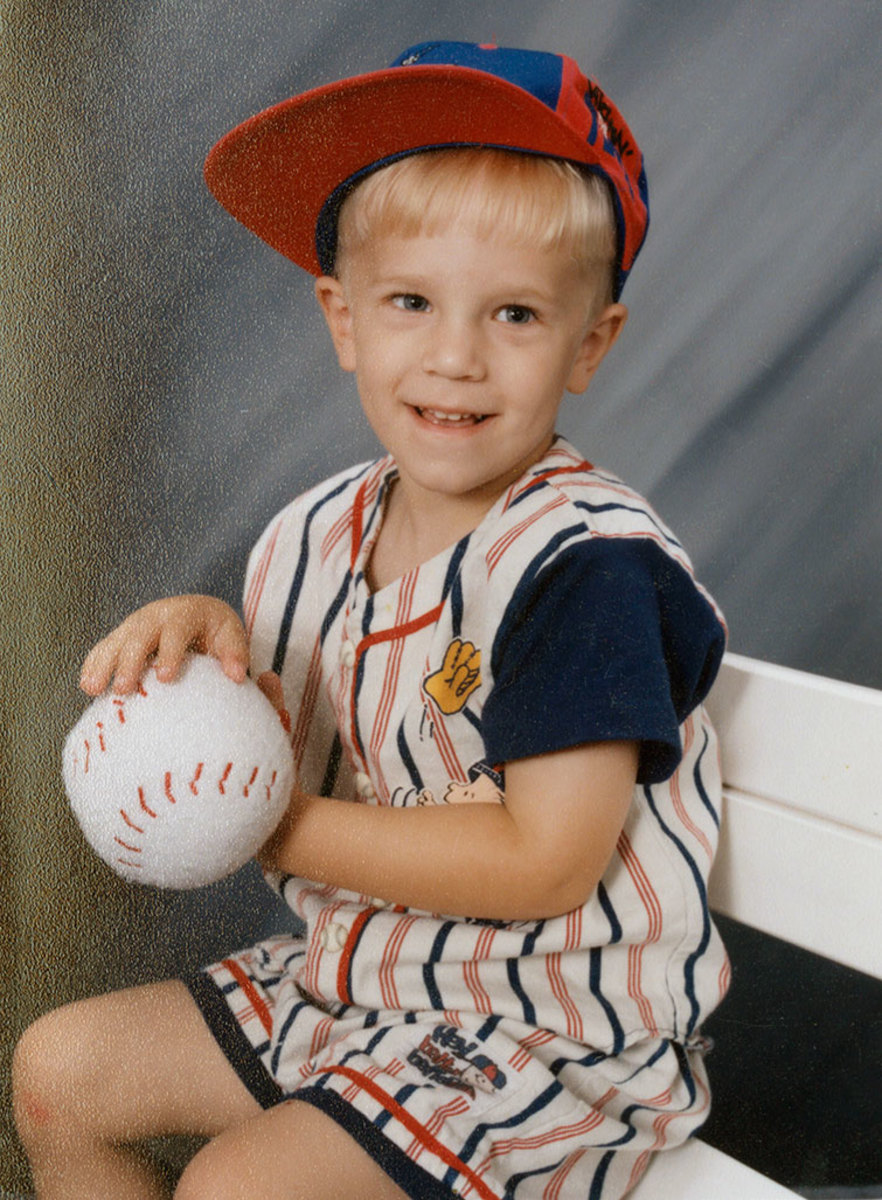
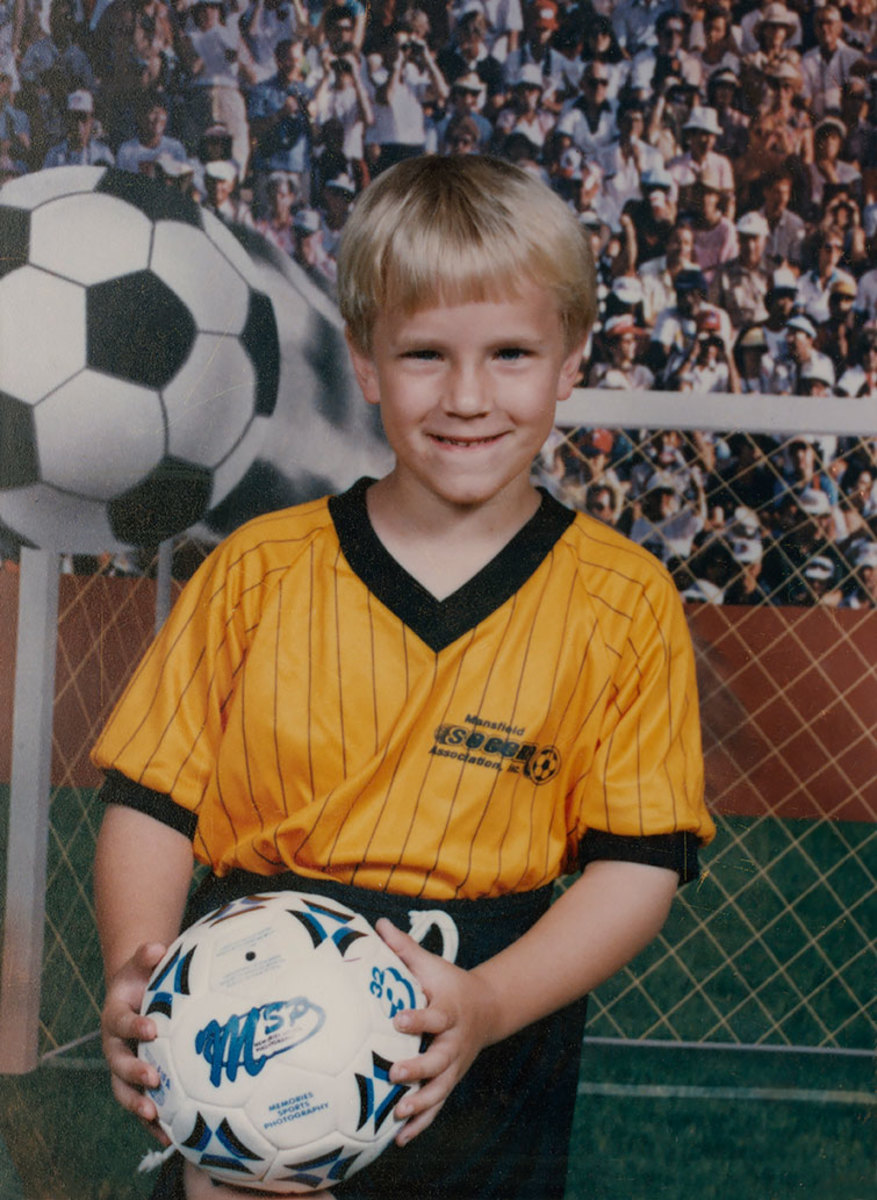
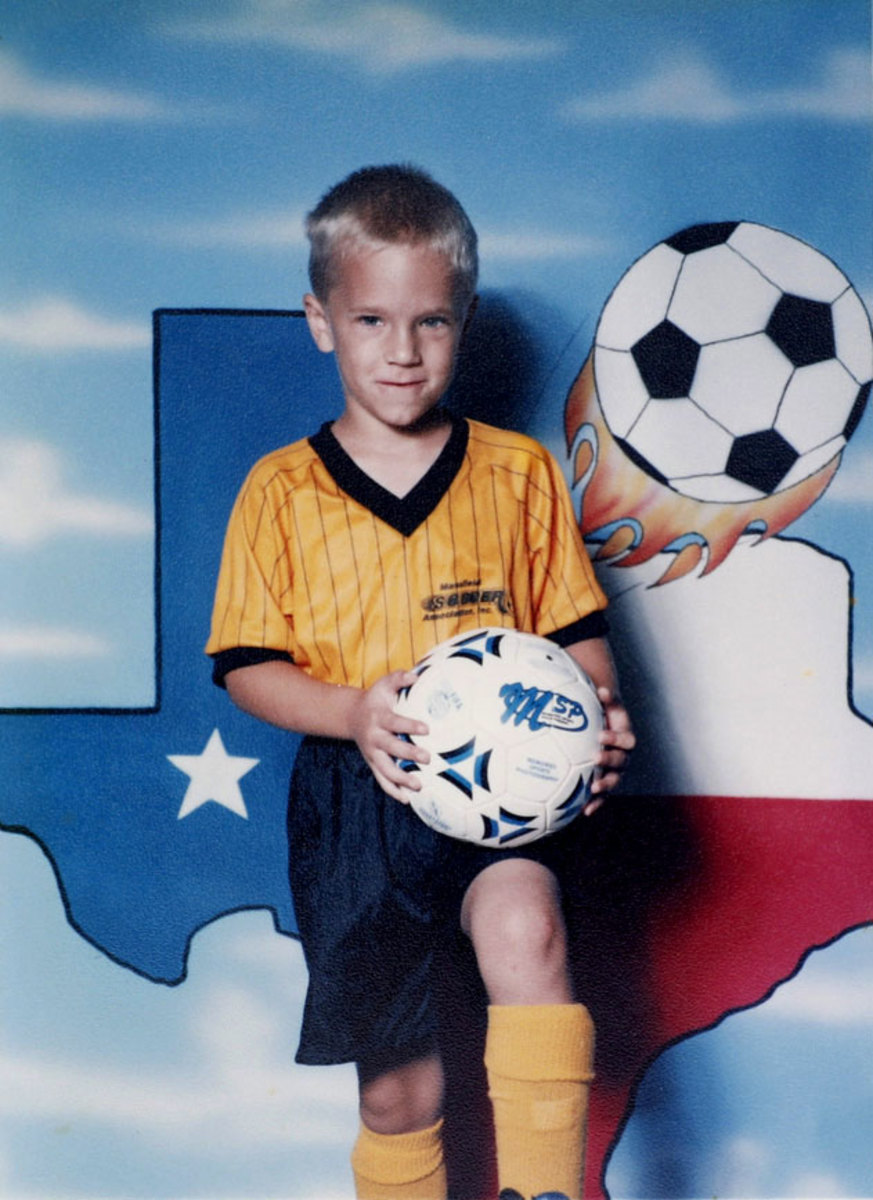
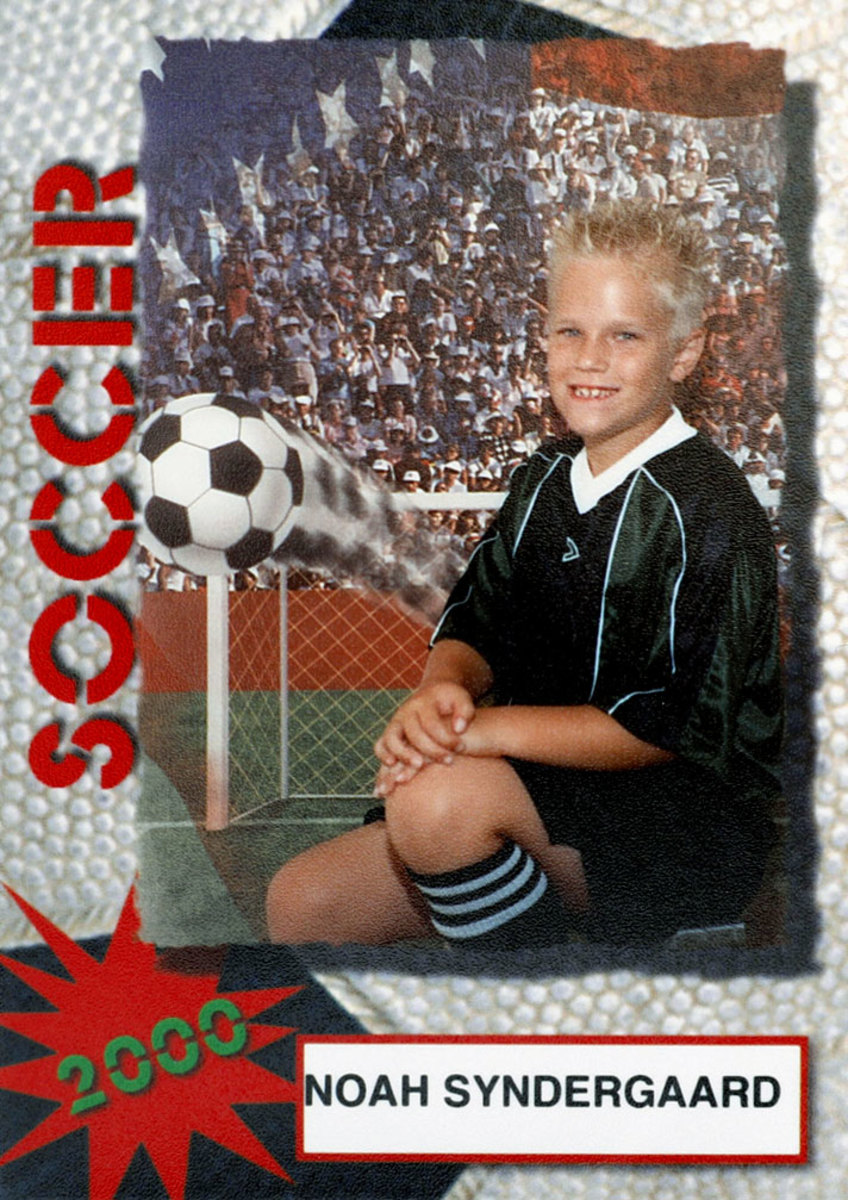
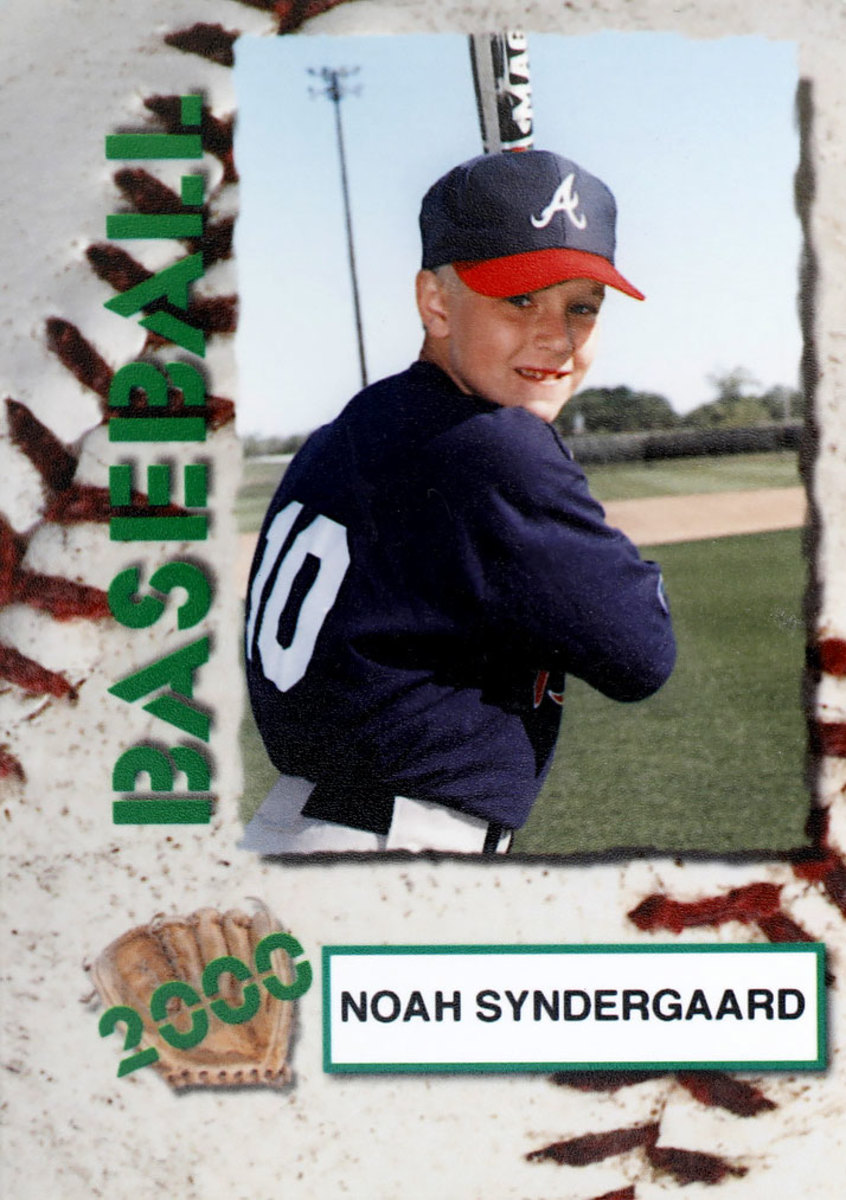
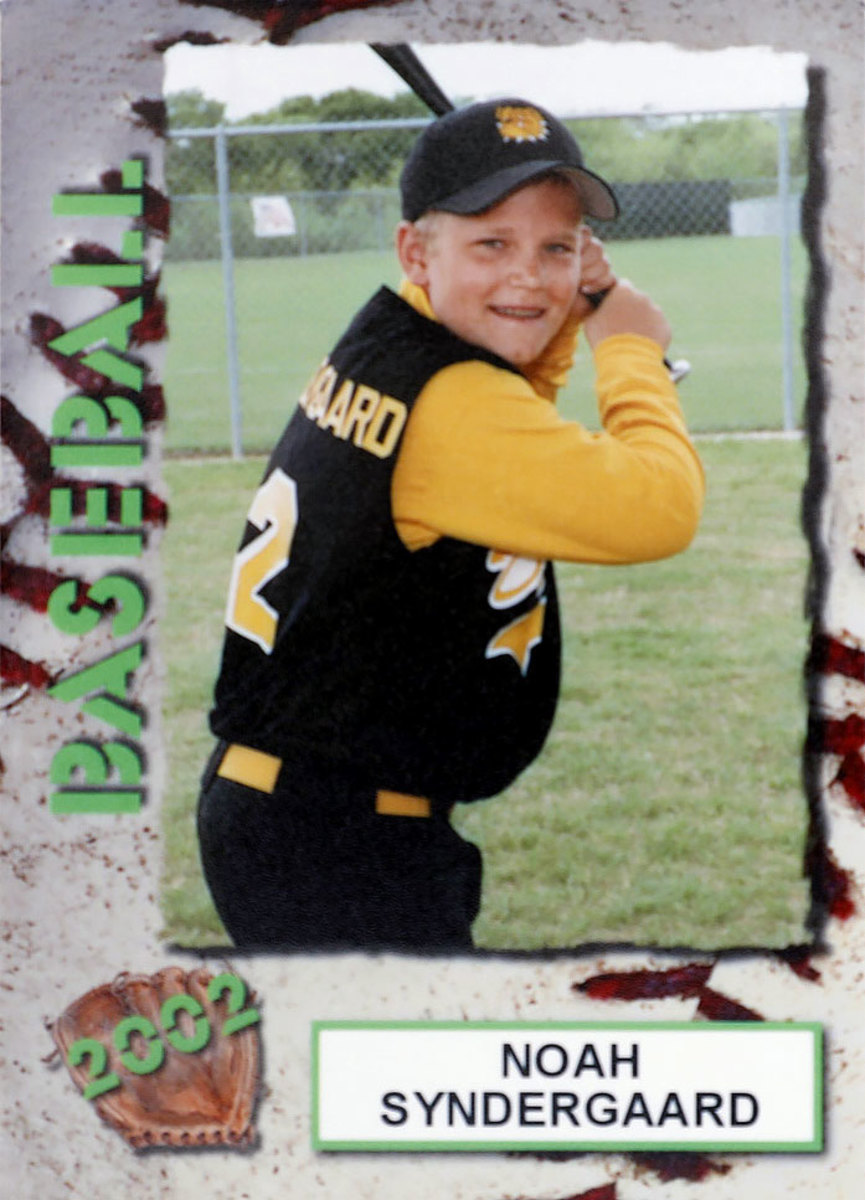
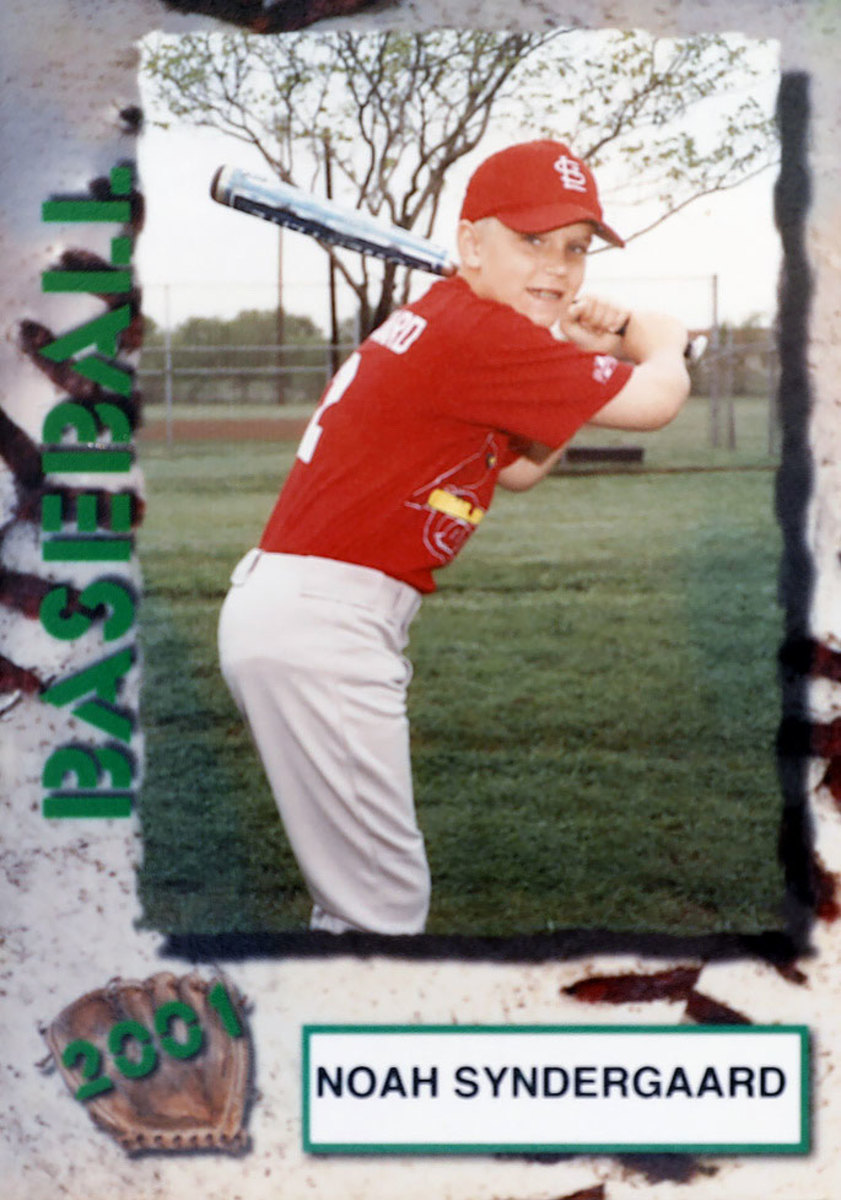
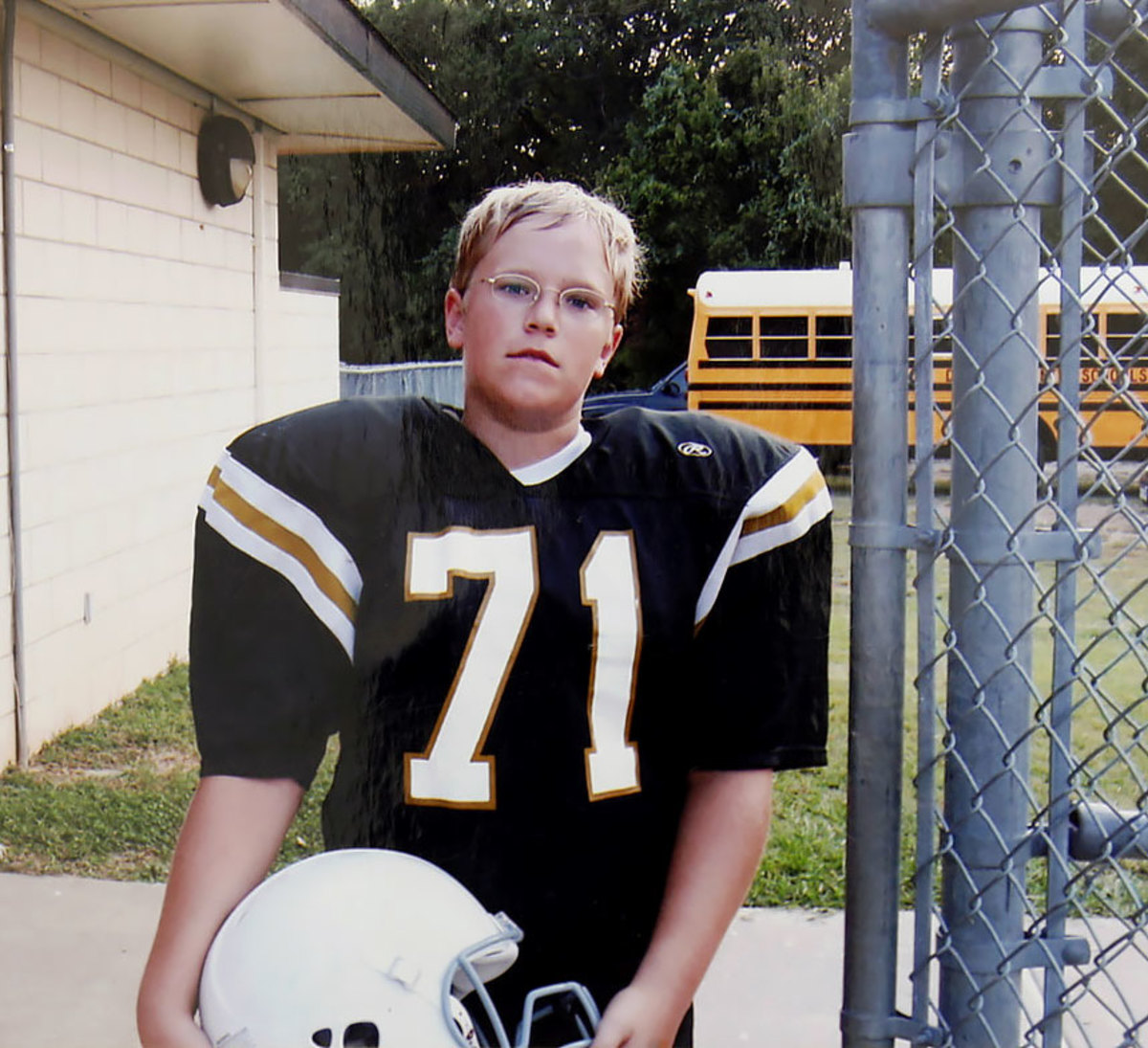
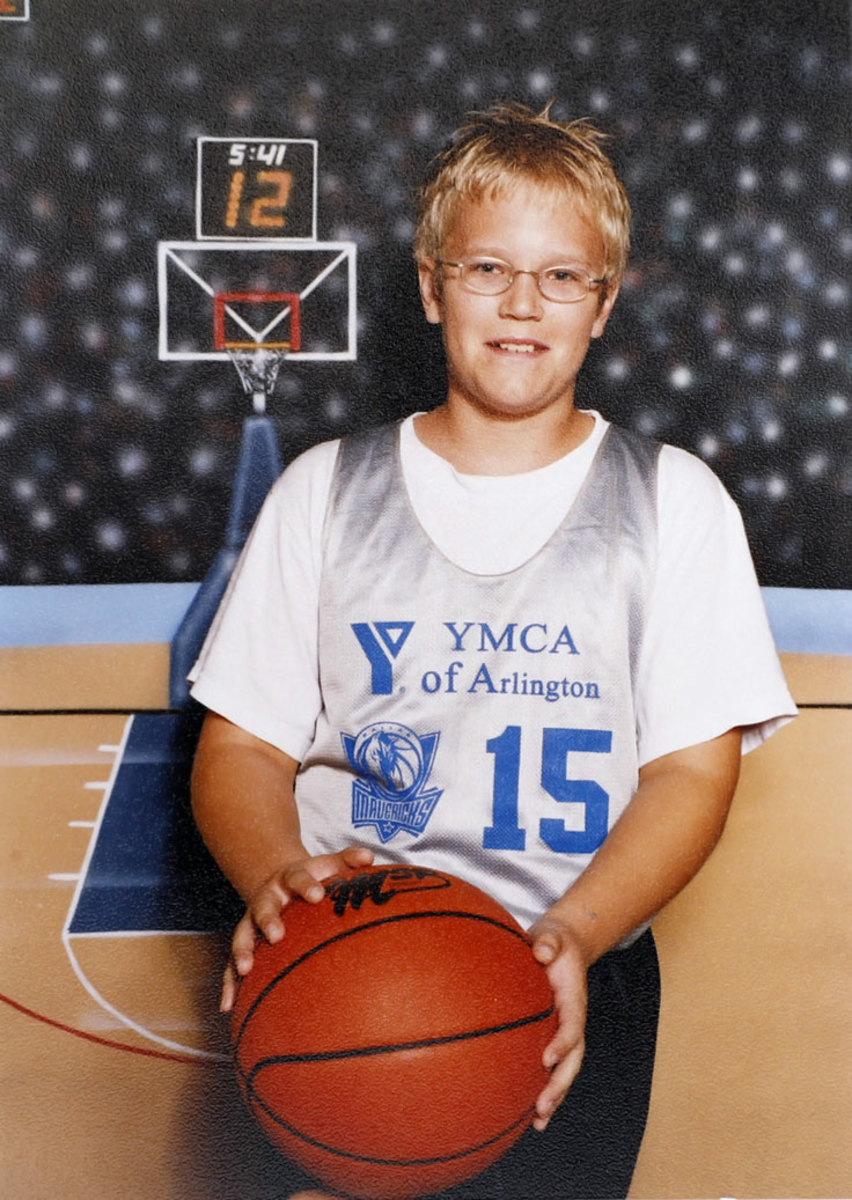
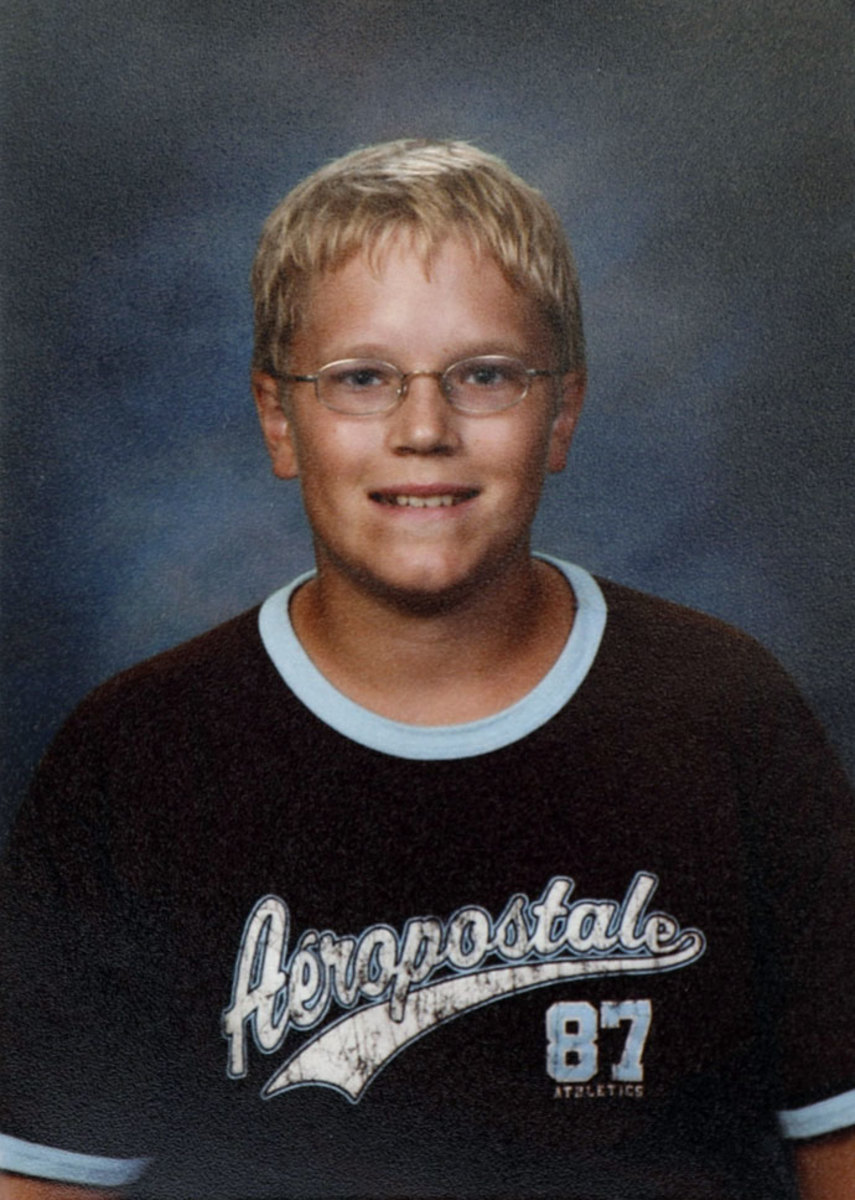
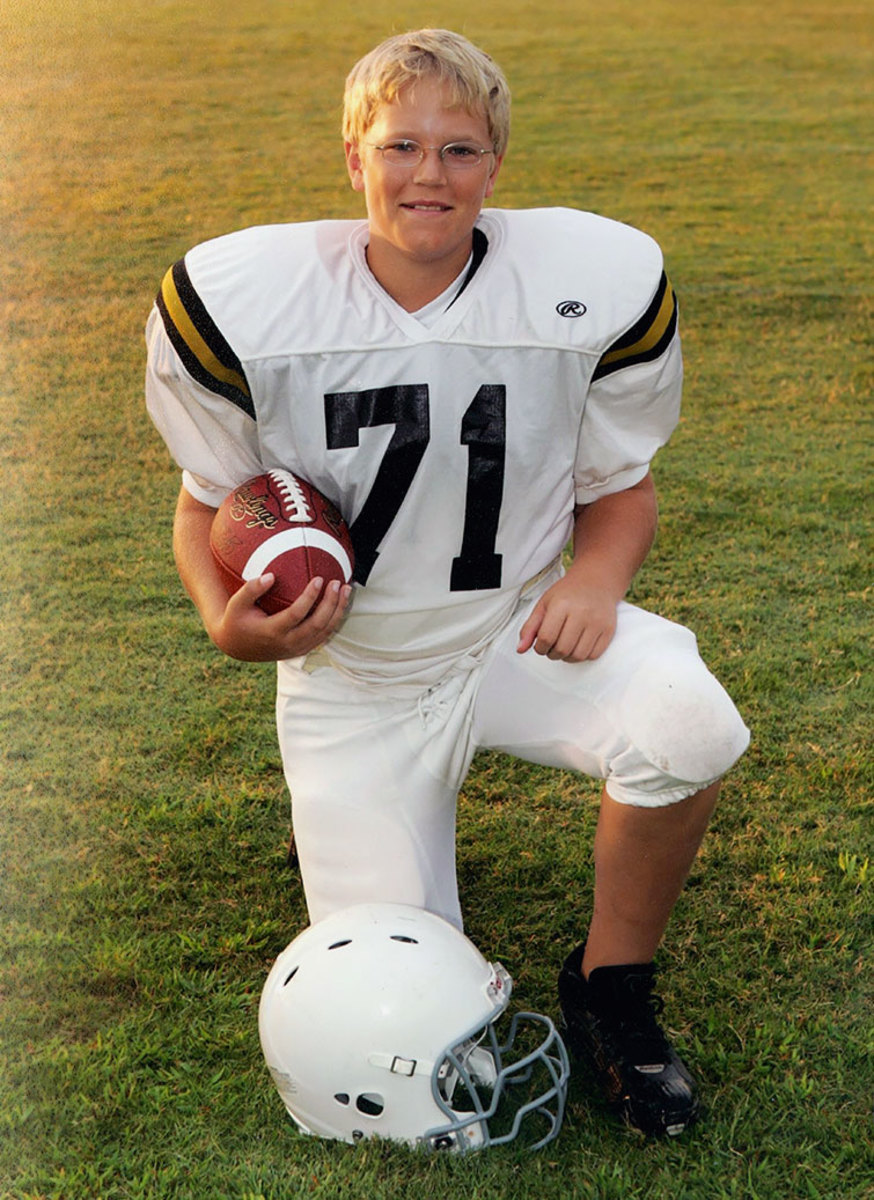
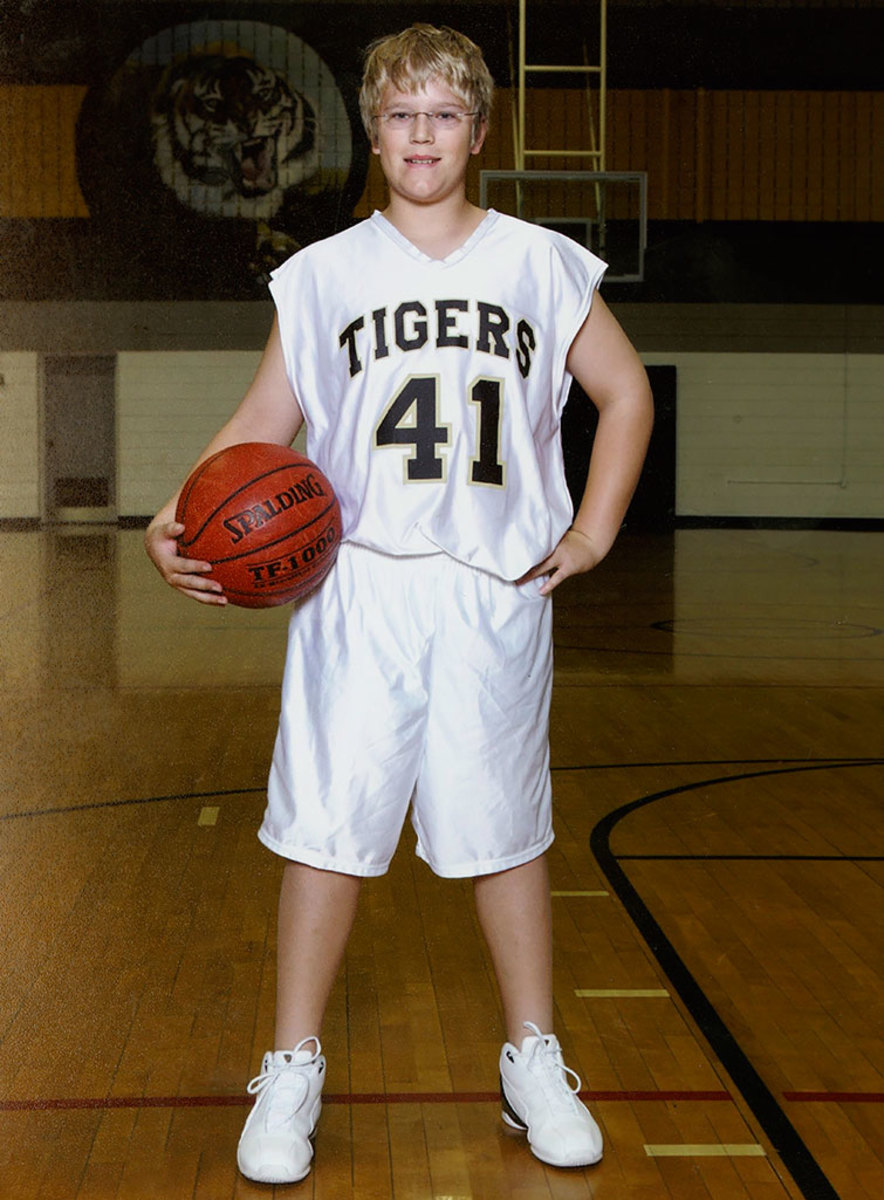
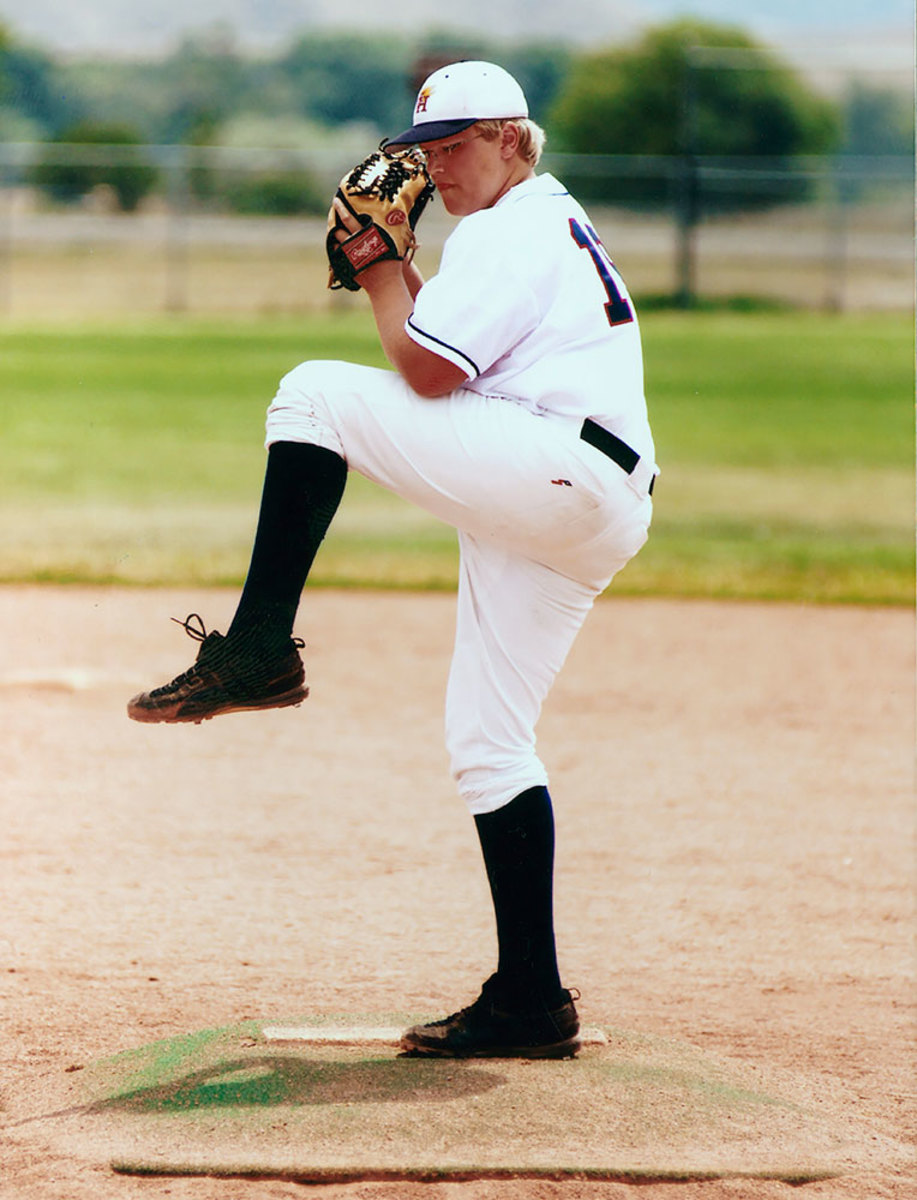
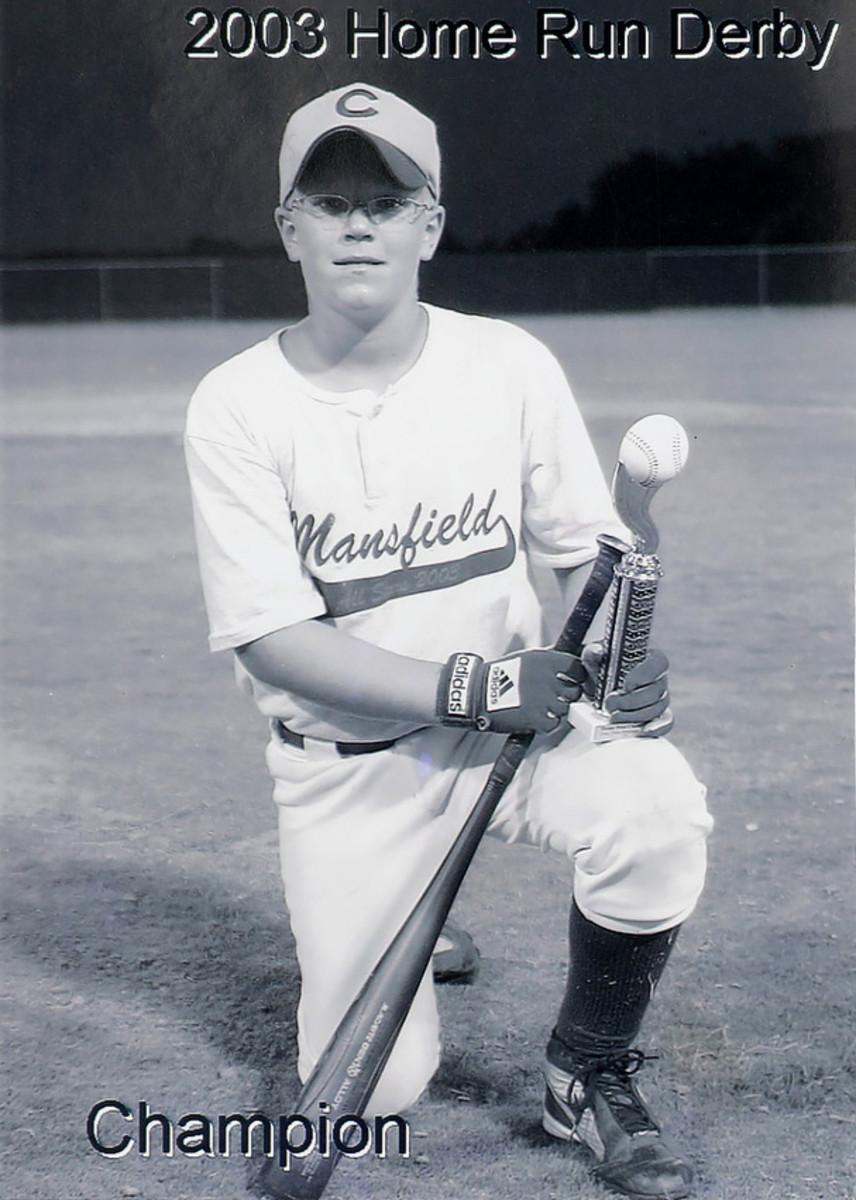
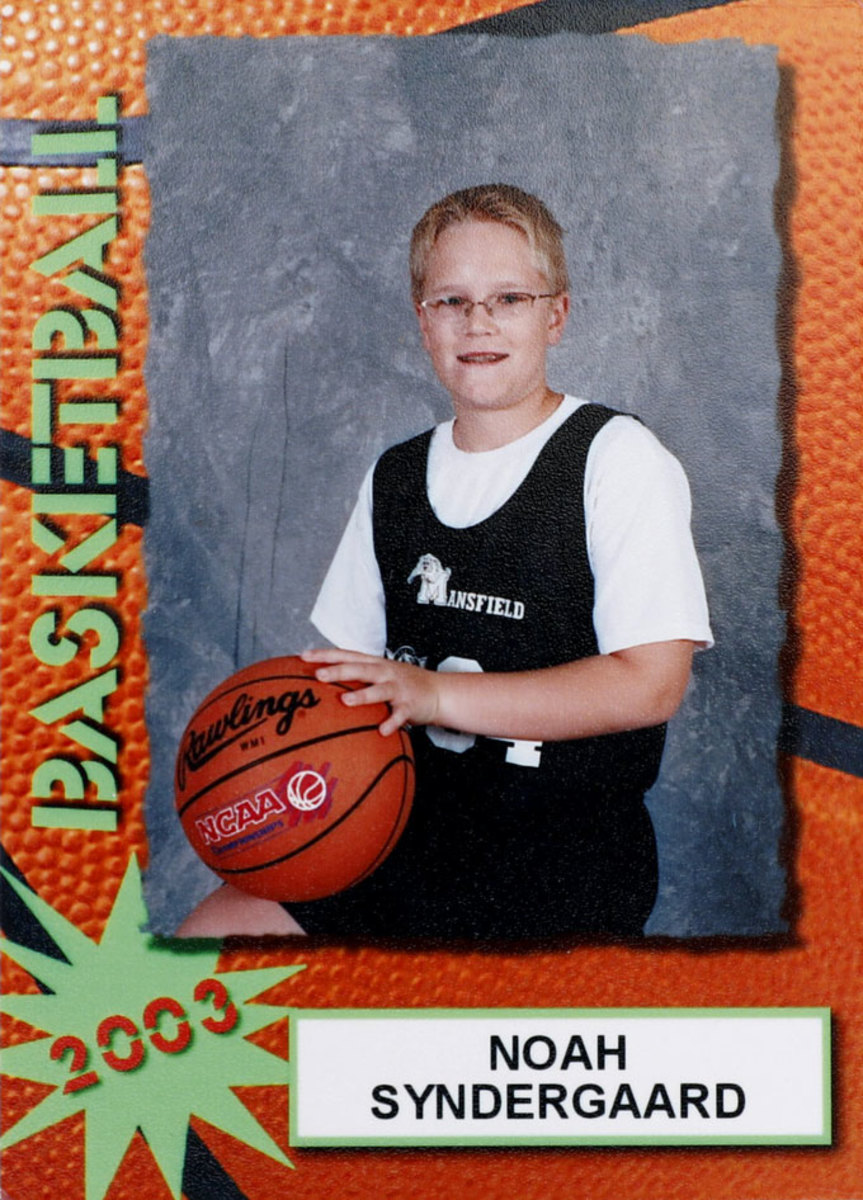
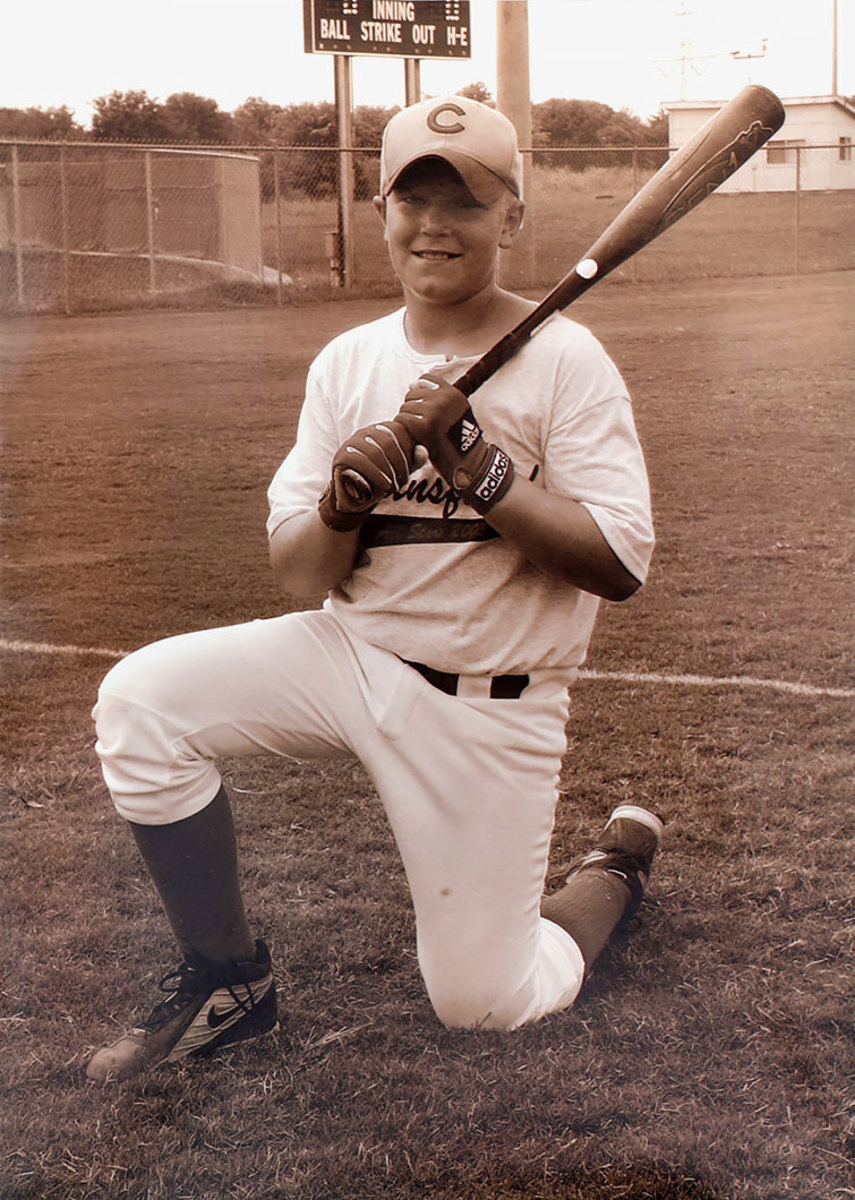
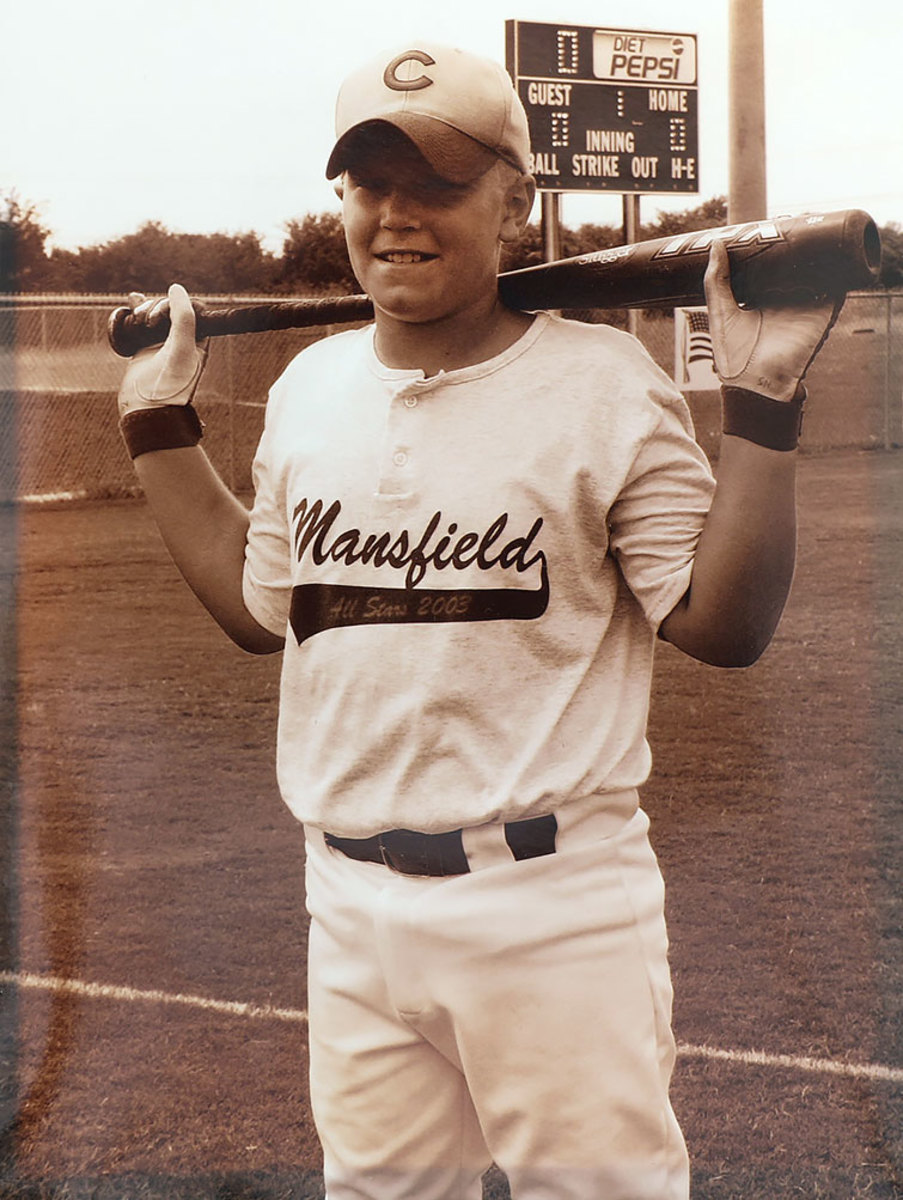
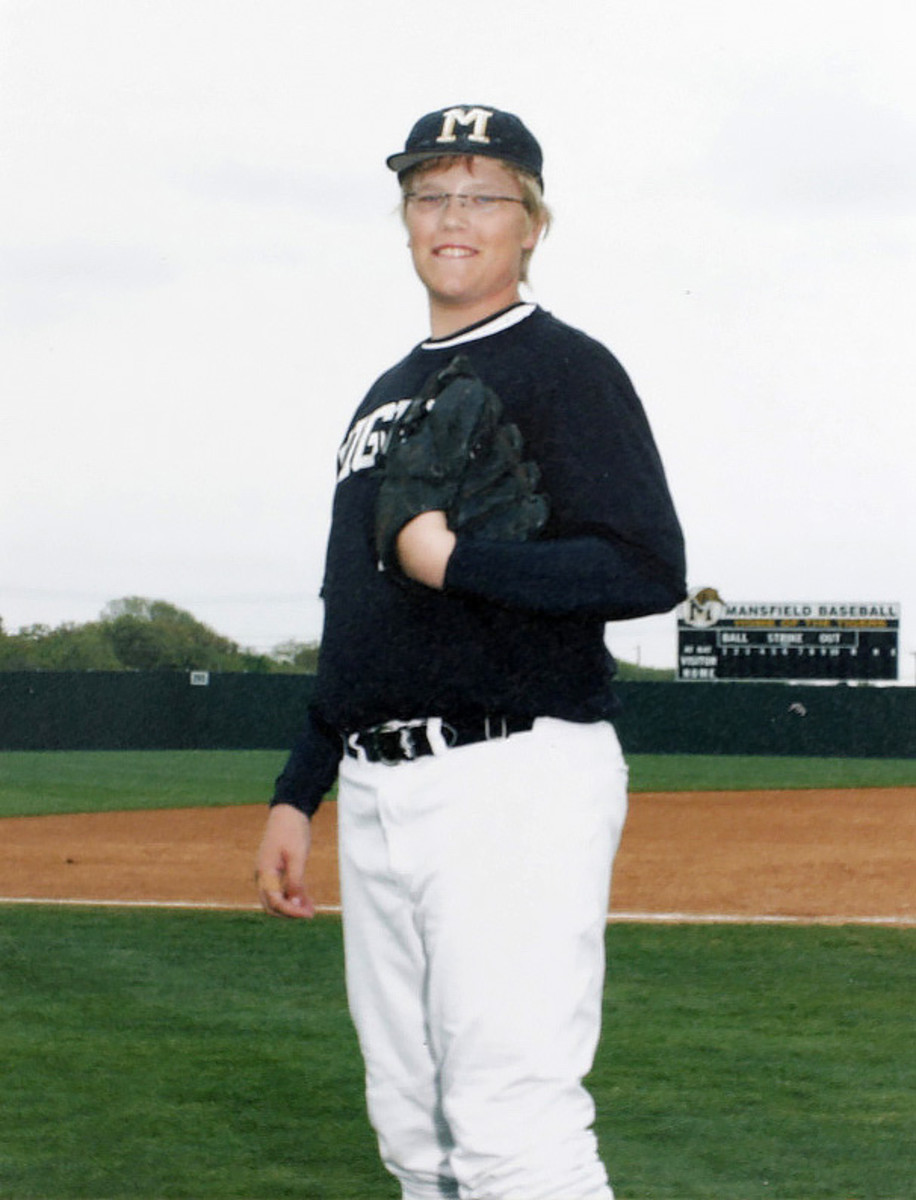
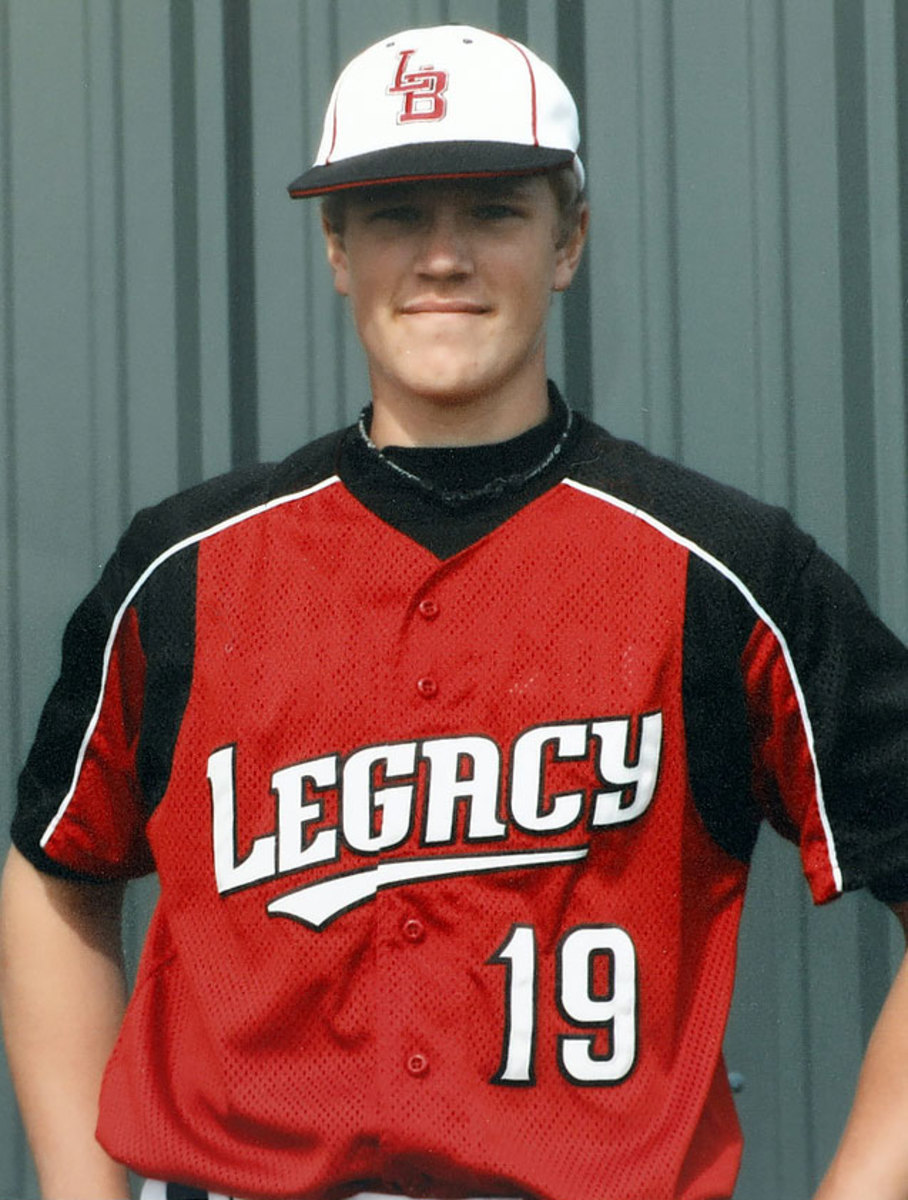
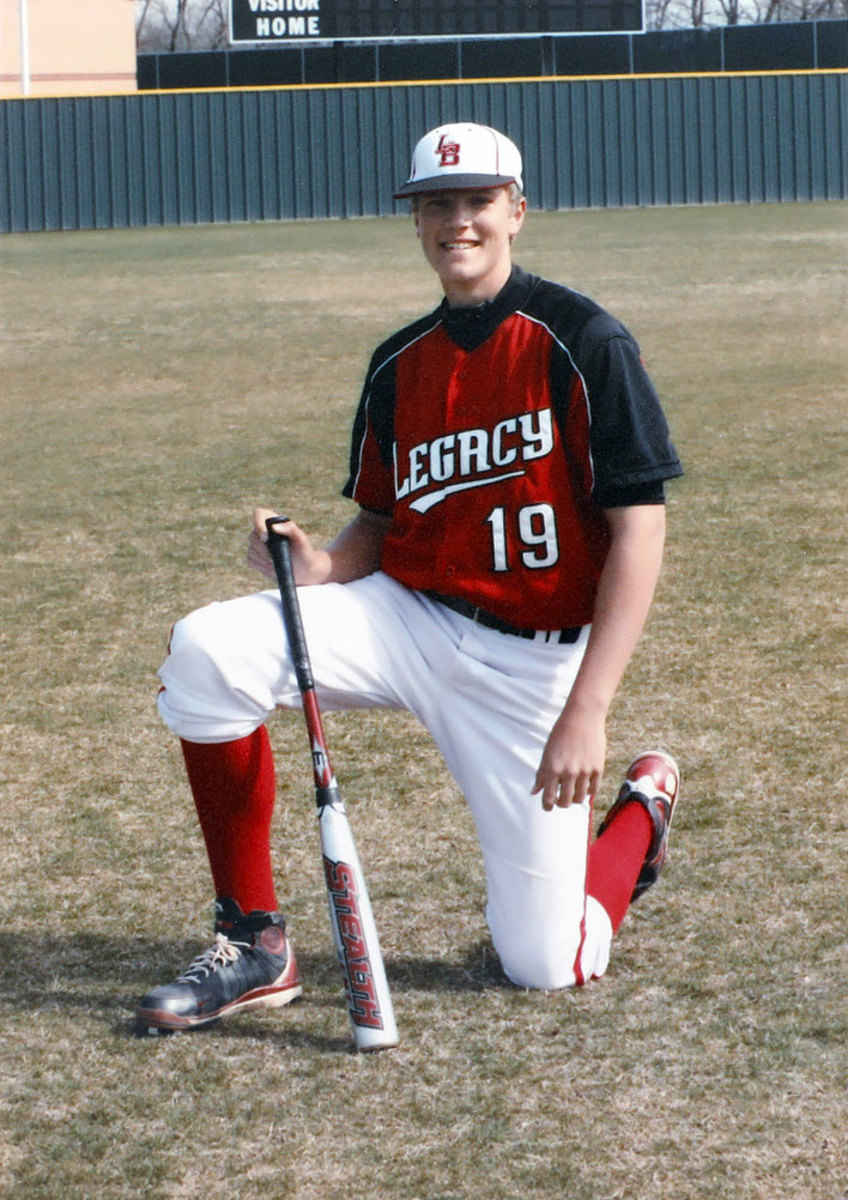
Syndergaard’s love of the gym started before his junior year at Mansfield Legacy High—he had switched schools the previous summer—when he asked his dad to take him to the YMCA to run and to try the workouts he’d read about in Muscle & Fitness. Brad would sit in his truck and page through the Fort WorthStar-Telegram while his son began to transform himself. “I’d always been self-conscious of my weight, how I appeared to other people,” Noah says. “I wanted to change that. Then I got hooked.”
Genetics took care of the rest. Heidi’s family was tall. Brad’s was strong. As a kid in Peterson, Iowa, Brad used to watch his father, Ken, pick up four 75-pound bales of hay, one under each arm and one in each hand, and walk out to feed their cows. Noah’s friend Michael Smith, a pitcher in the Angels’ farm system who is two years older, was working out at a 24-Hour Fitness during his first Christmas break from Dallas Baptist University when a tall, lean stranger approached him.
“Hey, what’s up, Mike?” the stranger said.
“Do I know you?” Smith said.
“Dude, it’s Noah.”
“You are not Noah.”
Syndergaard had reached 6' 3" and 190 pounds entering his senior year and could throw in the low 80s. He hadn’t been selected for any summer all-star teams. An Angels scout visited his family in November, but that was a rarity. He figured he would follow Smith to Dallas Baptist.
It wasn’t long before he gave scouts no choice but to pay attention to him—particularly one from the Blue Jays named Steve Miller. Texas is a difficult place to scout high school players because the schools are far apart and games are played only on Tuesdays and Fridays. It’s particularly hard for a newcomer, and in February 2010, Toronto had just recently moved Miller from the upper Midwest. One day he found himself on the side of the road, scanning the newspaper for games to watch after the starter he planned to see got rescheduled.
He ended up at Mansfield Legacy, where he was struck by two things. One was the pitcher, whose name he couldn’t pronounce: “This big, beautiful body with a really athletic and polished delivery and outstanding arm action.” The other was that he was the only scout there.
That wouldn’t last. David Walden, Mansfield Legacy’s first-year coach, implored his ace to maximize his remade body. He was convinced Syndergaard could throw much harder, if only he had the confidence to try. “Noah,” he would say, “when are you going to let the ball go?” As the spring progressed, Syndergaard started to. One game he hit 92. The next, it was 93. A few weeks later, the Broncos’ catcher could hardly get his glove on Syndergaard’s fastball.
“Do you know how hard you threw that game?” someone asked Syndergaard.
“No.”
“You hit 97.”
“What?”
No Pipe Dream: Tigers pitcher Michael Fulmer is the AL Rookie of the Year—and a plumber
Legacy’s stands started to fill with scouts, but no one watched Syndergaard more than Miller. He graded Syndergaard’s fastball a 70 on the standard 20 to 80 scouting scale, which meant that he projected it to reach 94 to 96 mph in the big leagues. Miller’s bosses were skeptical. That year there were only nine major league starters whose average fastballs exceeded 94. “So you’re saying this guy’s gonna be a freak?” they asked him.
In Walden’s memory, the last three high school pitches Syndergaard ever threw—at the end of a roughly 100-pitch outing—came in at 95, 96 and 97 mph. “I was light on that 70,” Miller says now.
On June 1, Baseball America had ranked Syndergaard the 32nd-best prospect in Texas. A week later Toronto picked him 38th in the draft.
The Noah Syndergaard of just three years earlier had vanished. He had a girlfriend, a blazing fastball and, best of all, a professional contract, with a $600,000 signing bonus. “I had been kind of growing up in this bubble,” he says. “Once I got drafted, I finally figured out what was outside of it.”
*****
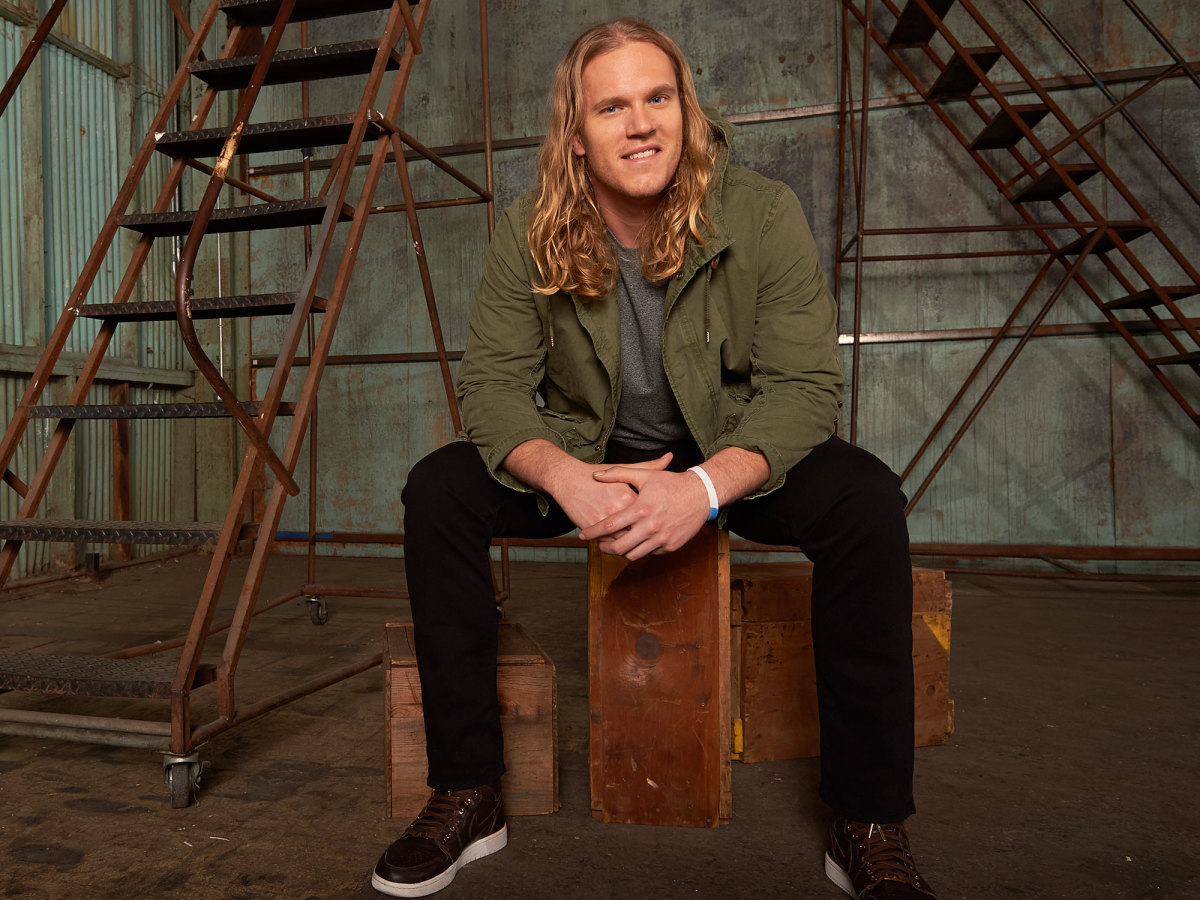
Syndergaard began growing out his hair when he was with Triple A Las Vegas in 2015, two years after Toronto traded him and catching prospect Travis d’Arnaud to the Mets for knuckleballer R.A. Dickey, then the NL’s reigning Cy Young winner. People were already calling him Thor, due to his Nordic surname and Hemsworthian size and strength—his belated growth spurt continued long after high school—and he figured he’d run with it. “My hair’s kind of a personality now,” he says. “It’s kind of who I am.” It requires maintenance, and expensive shampoo and conditioner. He currently uses a product named Caviar, which runs $32 per 8.5-ounce bottle. “If I gotta go to Sephora and pick out some high quality s---, I’m gonna do it,” he says. It’s worth it. “All the girls want to braid it, for some reason.”
He’s also cultivating other aspects of his image. Syndergaard admires the tough old gunslingers, like Bob Gibson and Nolan Ryan, and emulates them on the mound. He famously threw the first offering of his World Series start at 98 mph directly over the head of Royals shortstop Alcides Escobar, who had been swinging at—and -hitting—almost every first pitch he’d seen that October. “If they have a problem with me throwing inside,” he said afterward, “then they can meet me 60 feet, six inches away.” During his New Era shoot, he had the quote—which he insists was off-the-cuff—embroidered onto a custom hat.
“I never said anything had to be physical about that altercation,” he says. “If they wanted to come meet me out there, I’m gonna give them my side, they can give me theirs, and we can have a discussion. I’ve never been in a fight in my life. But I like my odds.”
Off the field, he is goofier. He loves comedy, that haven for outsiders, and frequents clubs around New York City. Via clips on Instagram, he has recently become interested in a sitcom that ended its run when he was five: Seinfeld. “I love Kramer,” he says.
He displays his own droll chops on a web show for the Mets. In one episode Syndergaard dresses up in a full Thor costume and walks around New York. “Excuse me, sir,” he asks a man wearing a Knicks hat. “Can you tell me how to get to Odenheim, please?”
“Where’s that?”
“I was hoping you could tell me.”
The man thinks for a moment. “Probably in the Bronx.”
Winter Report Card: Mets keep Cespedes, Walker but otherwise stand pat
On the Mets he is closest with the younger, fringier players—he lived with outfielder Michael Conforto last season and plans to room with pitcher Robert Gsellman this year—but he connects with everyone. During spring training last year in Port St. Lucie, Fla., Syndergaard persuaded slugger Yoenis Cespedes, who was drawing attention for pulling into the parking lot in a series of tricked-out cars, to get his ranch hands to drop off a pair of steeds. The two rode into camp one morning as cameras rolled. “There were times where I was like, I cannot control this beast right now,” says Syndergaard.
His relationship with Matt Harvey, whom he passed last year as the team’s ace, is more businesslike. “It’s pretty good,” he says of their rapport. “I would say so.” Harvey has become guarded after a few headline-grabbing years in the New York spotlight, but his younger teammate is generally an open book, especially on social media, which he loves. There he expounds on things like his distrust of the mascot Mr. Met, his hatred of the wave and the magnificence of Bartolo Colon. “Baseball has a way of ripping your heart out, stabbing it, putting it back in your chest, then healing itself just in time for Spring Training,” he tweeted after the wild-card loss. On New Year’s Eve he issued another observation, on Instagram. “Douche,” he wrote in the comments on a video posted by Nationals rightfielder Bryce Harper, igniting baseball’s first mini-controversy of 2017.
He was just messing around, he says. “Bryce and I aren’t buddy-buddy, but we see each other out, we acknowledge each other. Everybody loves a little bit of rivalry. He and I have the same goal: to make baseball fun again. Draw more fans, draw more excitement to the game.”
If it was fun for fans, it’s also fun for him. Not so long ago, he was invisible. Now he has the power to create a national stir by typing a single word.
*****
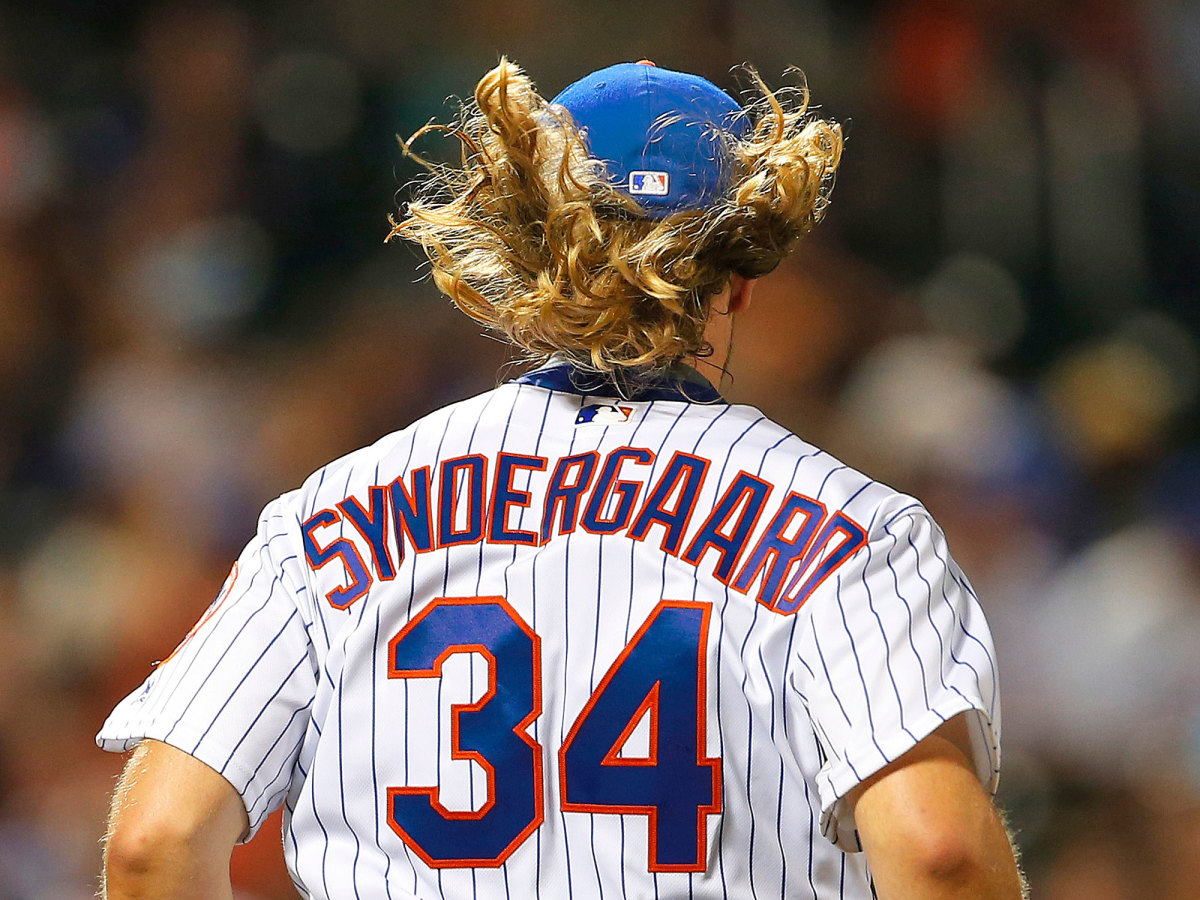
For one of his boyhood birthdays, Syndergaard’s parents took him and some friends to an MLS game at the Cotton Bowl. Afterward, he went down to meet some of the Dallas Burn players. All of them were nice to him, but one stood out: Ted Eck, who was nearing the end of a long and winding career. Eck spent 10 minutes with him, just talking. “I can remember every minute of it. How I was sitting, what he looked like—a little bit like Richard Branson,” Syndergaard says. “You just never know if you’re going to create some kind of impact with any little youngster.”
Syndergaard loves living in New York during the season, considering it the best city in the world, even though it meant that he spent much of last summer squeezed onto a full-size bed in what was technically the study of the Upper East Side apartment he shared with Conforto. His is not the doormen-and-black-cars, hermetically sealed version of the city occupied by many celebrities. His favorite off-day activity is to rent a CitiBike and cruise around Central Park, stopping and talking to anyone who recognizes him—and he is very recognizable—the way Eck did with him. “I don’t see it getting old, or me thinking it’s some kind of burden,” he says.
That might be because despite the armor—the muscles, the heater, the glare, the drollness and the braidable blond tresses—he remains the kid in the yearbook photo. “Underneath is still someone very innocent,” says Syndergaard, who speaks to his mother at least twice every day. “When it’s needed, I can transform into this big guy with a fastball and great hair, tough as nails. But I’m still a geek and a nerd inside.”
The penthouse duplex in uptown Dallas he has shared for the past two off-seasons with three roommates—two medical laser salesmen, who he met at a teammate’s bachelor party, and a junior college baseball coach—has all of the features you would expect of a bachelor pad occupied by guys in their 20s: huge TVs, an enormous beanbag chair, piles of clothes and electronics, a stove they have only recently learned to use. Its most unusual item, though, is in Syndergaard’s sparsely furnished bedroom, hanging on the wall directly above his pillow. It is among the first things he sees when he wakes up in the morning, a daily reminder of who he is now. It is Mjölnir—the hammer of Thor.
